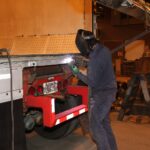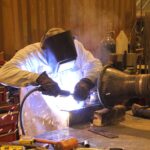Welding Services
 Welding services are at the core of any metal fabrication shop and Broadway Metal Works excels in this area. Our workforce has many years of experience welding every conceivable configuration of metal. We pride ourselves on the quality and craftsmanship of the welding services we offer. We offer qualified welders in Steel, Stainless Steel, Aluminum, Brass and Carbon. Stick, MIG and TIG are all specialties. Welding can be performed in our plant or on your job location. Here’s a brief explanation of the types of welding available courtesy of Wikipedia. Hyperlinks are provided for your use to learn more.
Welding services are at the core of any metal fabrication shop and Broadway Metal Works excels in this area. Our workforce has many years of experience welding every conceivable configuration of metal. We pride ourselves on the quality and craftsmanship of the welding services we offer. We offer qualified welders in Steel, Stainless Steel, Aluminum, Brass and Carbon. Stick, MIG and TIG are all specialties. Welding can be performed in our plant or on your job location. Here’s a brief explanation of the types of welding available courtesy of Wikipedia. Hyperlinks are provided for your use to learn more.
STICK
Shielded metal arc welding (SMAW), also known as manual metal arc (MMA) welding, flux shielded arc welding or informally as stick welding, is a manual arc welding process that uses a consumable electrode coated in flux to lay the weld. An electric current, in the form of either alternating current or direct current from a welding power supply, is used to form an electric arc between the electrode and the metals to be joined. As the weld is laid, the flux coating of the electrode disintegrates, giving off vapors that serve as a shielding gas and providing a layer of slag, both of which protect the weld area from atmospheric contamination. Because of the versatility of the process and the simplicity of its equipment and operation, shielded metal arc welding is one of the world's most popular welding processes. It dominates other welding processes in the maintenance and repair industry. The process is used primarily to weld iron and steels.
TIG
Gas tungsten arc welding (GTAW), also known as tungsten inert gas (TIG) welding, is an arc welding process that uses a non consumable tungsten electrode to produce the weld. The weld area is protected from atmospheric contamination by a shielding gas (usually an inert gas such as argon), and a filler metal is normally used. A constant-current welding power supply produces energy which is conducted across the arc through a column of highly ionized gas and metal vapors known as a plasma. GTAW is most commonly used to weld thin sections of stainless steel and non-ferrous metals such as aluminum, magnesium, and copper alloys. The process grants the operator greater control over the weld than competing processes such as shielded metal arc welding and gas metal arc welding, allowing for stronger, higher quality welds. However, GTAW is comparatively more complex and difficult to master, and furthermore, it is significantly slower than most other welding techniques.
MIG
Gas metal arc welding (GMAW), sometimes referred to by its sub-types metal inert gas (MIG) welding or metal active gas (MAG) welding, is a welding process in which an electric arc is formed between a consumable wire electrode and the work piece metal(s), which heats the work piece metal(s), causing them to melt, and join. Along with the wire electrode, a shielding gas is fed through the welding gun, which shields the process from contaminants in the air. The process can be semi-automatic or automatic. A constant voltage, direct current power source is most commonly used with GMAW, but constant current systems, as well as alternating current, can be used. There are four primary methods of metal transfer in GMAW, called globular, short-circuiting, spray, and pulsed-spray, each of which has distinct properties and corresponding advantages and limitations. Originally developed for welding aluminum and other non-ferrous materials in the 1940s, GMAW was soon applied to steels because it allowed for lower welding time compared to other welding processes.



